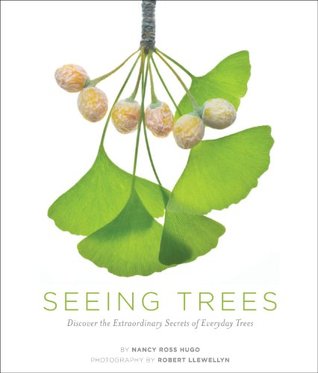Kindle Notes & Highlights
Read between
July 1 - July 7, 2019
Spring, it is said, advances up the United States at the average rate of about 15 miles a day, and ascends mountainsides at the rate of about 100 feet a day,
Trees identifiable as trees have been evolving for 397 million years
“Thinking is more interesting than knowing, but not so interesting as looking.” —JOHANN WOLFGANG VON GOETHE
The best way to see trees is to watch them regularly over many years.
My take on the naming issue is: learn to associate the trees you encounter with some name, even if you have to make it up.
The system of binomial nomenclature invented by Linnaeus—the Latin genus name followed by Latin species name—provides naming consistency.
it’s more important to be an honest, careful observer than it is to be an accomplished namer.
“What we can’t identify doesn’t exist for us,”
Watching the same tree part—big or small—over time is one of the many strategies for getting to know trees better,
the leaves and fruits of many trees are so far above our heads, we can’t experience them up close until they fall to the ground.
(The usda plant database and two volumes of Silvics of North America,
catkins)
Since basic tree biology doesn’t change, even old books can be a huge help,
sweetgum trees don’t begin to flower until they are at least twenty years old.
Drawing, photography, and journaling are other useful adjuncts to tree viewing.
If we all approached drawing as a means of fixing a memory as opposed to creating a work of art, we’d do more of it and see more as a result.
whole trees are surprisingly hard to capture photographically.
Dating observations is another way to enhance your viewing habits.
I remember being startled when I first noticed, because I penciled the dates into my field guides, that the wildflowers in my neighborhood bloomed on almost exactly the same dates every year.
Trees are incredibly consistent, programmed to respond more to unalterable patterns of daylight hours and night length than they are to fluctuations in weather.
a good pair of binoculars can dramatically increase the number of them you can see, and binoculars will obviously bring distant trees into closer view.
another useful piece of equipment is a hand lens, magnifying glass,
the three things that most enhance tree knowledge and appreciation are contact, contact, and contact.
“The real voyage of discovery consists of not in seeking new landscapes but in having new eyes.”
for birders, jizz means the overall impression or appearance of a bird garnered from such features as its shape, posture, flying style, size, color, voice, habitat, and location.
many trees have relatively small sun leaves and larger shade leaves.
Here’s the shortest leaf tutorial in the history of the world:
Shape, color, surface texture, fragrance, and vein pattern are other leaf characteristics to look for.
leaf shape varies not just between species but within species and even in individual trees.
(Open- pollinated trees, as opposed to trees created by controlled breeding, produce offspring that vary widely genetically.)
The mulberry has several leaf shapes (from leaves with no lobes to leaves with five),
name for these old leaves that stay on the trees until a strong wind or new spring leaves push them off—marcescent.
The action of leaves in air, when they’re falling, provides the most compelling images of this season.
leaf stalled in midair. This gravity-defying feat occurs when a leaf gets caught by the long, trailing silk line of a ballooning spider. Young
Making leaf collections is another way to relate to tree leaves.
anthocyanin, and its production depends on sunlight, rainfall, and weather, unlike the chemicals responsible for yellow, gold, and orange coloration, which remain more or less consistent from year to year.
I would argue for a tree leaf aesthetic that is closer to Japanese wabi-sabi
flowers of wind-pollinated trees, which include oak, willow, alder, walnut, beech, ash, sweetgum, boxelder, birch, elm, aspen, cottonwood, hickory, and mulberry, are known for many things but not for large, conspicuous flowers.
most wind-pollinated trees: they have flowers that are either male or female, as opposed to having flowers with both male and female parts as most (but not all) animal-pollinated flowers do.
Beech and oak trees, for example, have separate male and female flowers on the same tree
white ash and willow trees have separate male and female flowers, but they are usually on
different...
This highlight has been truncated due to consecutive passage length restrictions.
magnolias, serviceberries, and elms have p...
This highlight has been truncated due to consecutive passage length restrictions.
Red maple, alder, American elm, birch, white ash, and sassafras, for example, bloom before their leaves unfurl. Oak, walnut, hickory, sweetgum, and tupelo bloom as the leaves are emerging. Wild black cherry, sourwood, and linden bloom after their leaves have unfurled, and the native witch hazel Hamamelis virginiana, latest of the native North American trees to flower, doesn’t bloom until after it has lost its leaves in late fall.
(The terms panicle, raceme, spike, head, umbel, and corymb apply to the various tree flower arrangements just as they do to garden flowers.)
Oaks, hickories, chestnuts, mulberries, and walnuts have male catkins that whither and drop after they have released their pollen,
gymnosperms,
angiosperms
What most of us think of as cones are the female cones of a conifer—the woody structures,
Male conifer cones, often referred to as pollen cones, are usually much smaller and stubbier than female cones, they are simpler in structure, and they are much more numerous.


